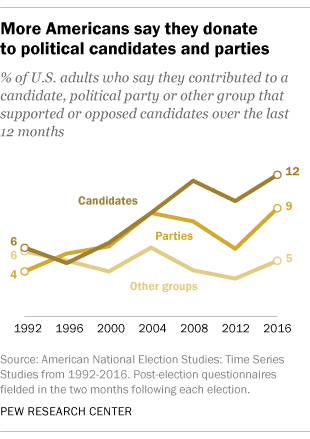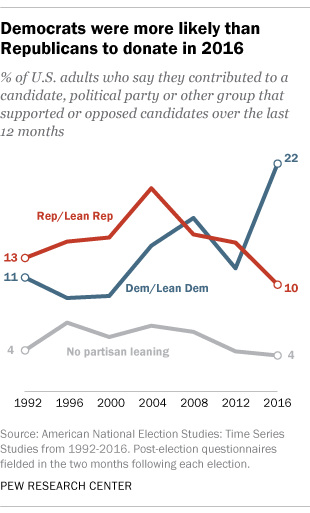Americans are increasingly likely to make political donations, with the share of adults who say they have donated directly to candidates doubling since 1992, according to data from American National Election Studies (ANES). Political donations from individuals represent a large share of campaign funding: In the 2016 election cycle, 71% of Hillary Clinton’s fundraising total and 40% of Donald Trump’s came from individual contributions, according to the Center for Responsive Politics.
Here are five facts about political donations from individual donors:

More Americans are making political donations. Americans are now more likely to contribute to political candidates and parties than they were two decades ago, according to surveys conducted as part of ANES. The share of Americans who say they have donated to an individual running for public office within the past year has doubled, increasing from 6% in 1992 to 12% in 2016. (The survey does not specify type of candidate.) The share of those who say they have donated to parties has also increased, rising from 4% to 9% across the same period, while the share making donations to outside groups working to elect or defeat a candidate – such as political action committees – has remained between 3% and 6%. Overall, the share of Americans who say they have donated to at least one of these groups within the past year has increased from 11% in 1992 to 15% in 2016.
Americans who are more politically engaged are more likely to donate. During the 2016 campaign, politically engaged Americans were much more likely to make political donations. Those who said they follow what is going on in government and public affairs most of the time reported donating at a rate of 28%, compared with less than 7% of those who follow government and public affairs some of the time or less often, according to a Pew Research Center survey conducted Sept. 27-Oct. 10, 2016. Among those who say they vote always or nearly always, 21% said that they made a donation, compared with 4% of those who seldom voted or voted only part of the time.

Democrats were twice as likely as Republicans to say they donated last year. In 2016, 22% of Democrats and Democratic leaners and 10% Republicans and Republican leaners reported making a donation, according to data from ANES. This marks the first election since at least 1992 when Democrats have been significantly more likely than Republicans to donate.
On average, between 1992 and 2016, 15% of Republicans and 14% of Democrats reported making a donation to a candidate, party or outside groups. For independents who do not lean toward either party, the share was 5%.

Higher-income, more educated and older Americans are more likely to donate. Nearly a third (32%) of those with family incomes of $150,000 or more say they made a political donation, compared with 7% of those with family incomes of less than $30,000, according to the fall 2016 Pew Research Center survey.
Education is also strongly associated with individuals’ likelihood of making a donation: 29% of those with a postgraduate degree reported doing so, compared with 7% of those with a high school diploma or less education, the survey found. The share is 24% among those with a college degree. In addition, older Americans are much more likely to contribute than younger Americans. The average donation rate for those ages 18 to 29 is 9%, compared with 12% for those 30 to 49, 14% for those 50 to 64, and 32% for those 65 and older.
Most Americans donate less than $100. Of all Americans who reported donating to a candidate or group working to elect a candidate, 55% reported donating less than $100, while 32% reported donating between $100 and $250, according to the fall 2016 survey. The remaining 13% said that they donated more than $250. Those who earn more also tend to donate more, however. Among those who donated, 27% of those with family incomes of $150,000 or more said they contributed more than $250, while 16% of contributors with incomes between $75,000 and $150,000 gave at least $250.
Note: See full topline results from the Sept. 27-Oct. 10, 2016, Pew Research Center survey (PDF).
